Orange variety of Meyer lemon: description, advantages and disadvantages, cultivation features
Lemons are grown not only in open ground and greenhouses - they are cultivated as indoor plants. Citrus trees easily take root in pots, and with proper care they bloom and bear fruit. To make indoor lemon look beautiful at home and produce large yields of delicious fruit, it is better to plant dwarf varieties. Meyer lemon is ideal for this. It is distinguished by its short stature and unusual orange fruits.
general description
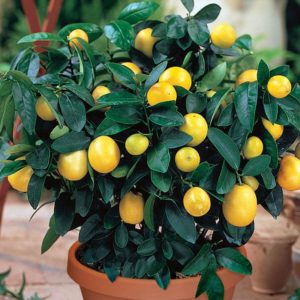
Meyer lemon is a natural hybrid of pomelo, mandarin and citron.. This is what makes it especially interesting for citrus lovers.
The plant is famous for its unusual color and taste of fruits, suitable for growing at home, despite the demanding care.
Origin story
There are 2 versions of the origin of Meyer lemon. According to one of them, this is the result of a natural crossing of mandarin, citron and pomelo, according to another, it was obtained as a result of long-term work by Chinese breeders from Cantonese lemon.
Lemon with orange fruits was grown for a long time in China as a tub crop. In 1908, the plant was brought to America by businessman and botanist Frank Meyer, in whose honor it received its name. Citrus quickly gained popularity among Americans and began to be actively grown in California nurseries. In 1930, the culture was brought to the USSR in an improved form.
Interesting! It is popularly called Chinese dwarf, Beijing and Chinese lemon. In Russia the name “Abkhazian citrus” is found.
In the 40s, when Meyer lemon was grown everywhere, an unpleasant feature was discovered: many specimens were infected with the dangerous tristeza virus. Moreover, on the hybrid itself, the consequences and symptoms of the disease did not manifest themselves in any way. The infection spread to other citrus fruits and led to the death of huge numbers of lemons around the world.
Because of this, the bulk of the Meyer lemons were destroyed. Already in 1950, a virus-free variety of the hybrid was developed. In 1970, the improved Chinese dwarf was again allowed to be grown.
The problem of Tristeza infection is still relevant. This is due to the fact that not all of Meyer’s offspring infected by the carrier of the virus were destroyed. There is a risk of buying not an improved version with high immunity, but an old clone that will infect other citrus fruits.
Characteristics
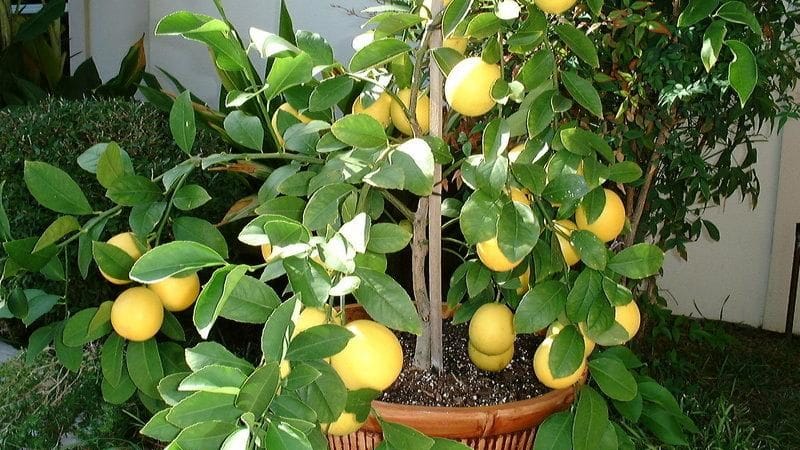
Chinese dwarf is one of the best options for growing at home. This is due not only to its miniature size, but also to other features. Basic plant parameters:
- Crown. At home, the height of the tree does not exceed 1.5 m. The crop tends to grow a large number of shoots even without formation. Unlike many other citrus fruits, Meyer lemon tends to form not a standard, but a bush. The branches are strong and not thick. A small number of small spines form on them.
- Leaves. The tree produces many hard and dense dark green leaves with a leathery texture, resulting in a dense crown. The leaves themselves are small, egg-shaped with a pointed end and jagged edges.The leaf blades differ from other citrus fruits in their smell: it is citrusy, but not lemony. In winter, active leaf fall is often observed, up to complete loss of leaves.
- Bloom. There are up to 4 of them per season, at which time a delicate aroma emanates from the plants. The first small inflorescences or single buds often appear within 2 years after planting. Many flowers are formed even on the shoots of the current year. The flowers are small, white or cream inside, with purple, lilac or pink streaks on the outside.
- Fruit. Miniature, round in shape, average weight - 80–100 g. The peel is thin, smooth and shiny without lumpy, orange tint. The yellow or orange pulp consists of 6–10 segments; 1 fruit contains up to 10 seeds. The taste is sweet and sour, juicy with light bitter notes. The fruit contains up to 51% juice of the total mass, which contains 3-4% less citric acid and 10-12% more fructose than regular lemons.
- Fruiting. The plant is early ripening: the fruits ripen within 8 months after the formation of buds. The first harvest is harvested 4-5 years after planting.
The transportability of fruits is low: due to their thin skin, they wrinkle and deteriorate during transportation.
Look what a Meyer lemon looks like in the photo.
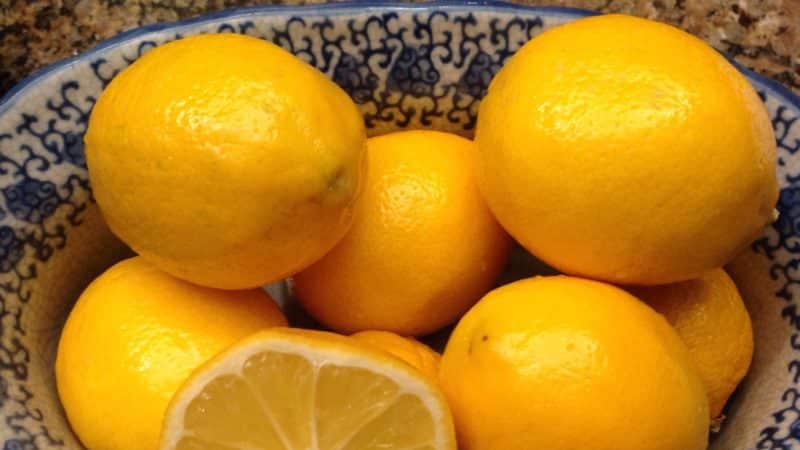
Resistance to negative factors
The characteristics of its care directly depend on the degree of resistance of the hybrid to various factors:
- Meyer lemon is characterized by increased cold resistance. It can withstand short-term cold snaps down to -10°C, which allows it to be grown in Abkhazia and the Caucasus (the northernmost countries where citrus fruits are cultivated in open ground).
- The plant is light-loving.If other lemons are not recommended to be grown on a southern windowsill, then for the Chinese dwarf this is where optimal conditions are observed.
- The culture is resistant to tristeza. At the same time, old clones carry the virus, but do not themselves suffer from its influence.
- In a cold room in winter, plant development stops until it warms up, but with optimal lighting and temperature, lemon can do without the dormant stage.
- The hybrid is demanding on watering and air humidity; if the conditions of care are violated, it begins to get sick and dies.
- It has no resistance to other diseases and is often affected by pests.
Although Meyer citrus is able to adapt to different weather conditions, it is quite whimsical. In order for the plant not to get sick and feel comfortable, you will have to pay enough attention to it.
Advantages and disadvantages
The hybrid has many advantages:
- unusual color, taste and aroma of fruits;
- early ripeness;
- ability to adapt to different climatic conditions;
- abundant flowering, formation of a large number of shoots;
- high productivity;
- does not require shading or winter dormancy;
- easily takes root;
- does not suffer from tristeza.
There are also some disadvantages of the hybrid:
- lack of immunity to fungal diseases;
- low transportability;
- demanding care;
- impossibility growing from seed;
- the need for mandatory formation and removal of excess inflorescences;
- the risk of buying an “old clone” - a carrier of a virus dangerous to other citrus fruits.
Growing technology
Even novice gardeners can grow a lemon tree with orange fruits at home. The plant requires attention and regular care, but you won’t have to spend a lot of time on it.
Optimal conditions
To prevent citrus from getting sick and to develop properly, it is important to provide it with optimal conditions for growth:
- Temperature. During the growing season it is maintained within +18…+25°C. +20°C is considered optimal. In winter, the plant is moved to a room with a temperature of +5…+12°C.
- Humidity. This figure should not be lower than 70%. In summer, in the morning and evening, the leaves are sprayed with warm, settled water. In winter, use a humidifier or place containers of water near the lemon.
- Lighting. The culture requires 12 hours of daylight; it is better to place it on a southern windowsill. When the sun is most active, the window is shaded with a translucent curtain. If the lemon is dormant in winter, it is not necessary to use additional lighting.
If it is not possible to provide citrus with a lower temperature in winter, it is grown as usual. In this case, it will not be at rest. Then you will have to use lighting with phytolamps placed at a distance of 15–20 cm from the pot.
Important! Meyer lemon does not tolerate sudden changes in temperature. Before taking it outside, bringing it into the house or lowering the temperature for the winter, the tree must be hardened.
Rules for planting and transplanting
For planting and replanting a plant, it is important to choose suitable soil. Lemons are not recommended to be planted in peat soil. Therefore, it is better to buy either special soil for citrus fruits or prepare it yourself.
For young plants, the soil mixture should look like this:
- turf - 2 parts;
- humus - 1 part;
- sand - 1 part;
- leaf soil - 1 part.
All ingredients are mixed. Add 1 tbsp to a bucket of soil. ash and 1 matchbox of superphosphate.
For mature plants use heavier soil:
- turf - 3 parts;
- leaf soil - 1 part;
- sand - 1 part;
- humus - 1 part;
- clay - 1 part.
Store-bought plants must be replanted in a new pot. For the first picking (even if the plant is already mature), use the first soil option.
Lemons are replanted annually before the first fruiting. Then the frequency of procedures is reduced to 1 time every 2-3 years. Large adult plants are not replanted - the top part of the soil is removed from the pots, replacing it with a new nutrient mixture.
In addition to the soil, you will need drainage. It eliminates the risk of moisture stagnation, which is detrimental to citrus fruits. The thickness of the drainage layer in the pot should be at least 1 cm.
Important! The soil, drainage and containers must be disinfected before use using high temperature or a dark pink solution of potassium permanganate.
Containers for each new transplant are taken 5-6 cm larger than the previous one. Pots should not be much larger than the plants.
Further care
Proper and regular care is the key to health and rapid growth of the crop. This determines whether the plant will produce a harvest.
Home care for Meyer lemon:
- Watering. In summer, lemon is moistened once a day, in the morning or evening, when the sun is inactive. In this case, irrigation should not be abundant. Some gardeners pour water into a tray under the pot. In winter, the plant is watered more often than 2 times a week.
- Feeding. In spring, summer and autumn, lemon is fertilized once every 2 weeks. They use special formulations for citrus fruits, chicken droppings, rotted manure, infusion of vegetable peelings, fish broth, coffee and tea.
- Formation. When the central trunk reaches 20 cm, pinch the growth point. Branches of the first order are shortened to 25 cm. Shoots of subsequent orders are pinched when they reach 15–20 cm.
- Trimming. Every year, dried, weak and damaged shoots are removed from the tree.
- Bloom. If this happens in the second year, all the inflorescences are cut off so that the tree does not start to hurt. Further, the procedure is carried out only if too many flowers have formed: this will increase the yield.
- Cleaning. Every week the leaves are wiped with a damp cloth. Once a month, wash the lemon in the shower.
Possible problems
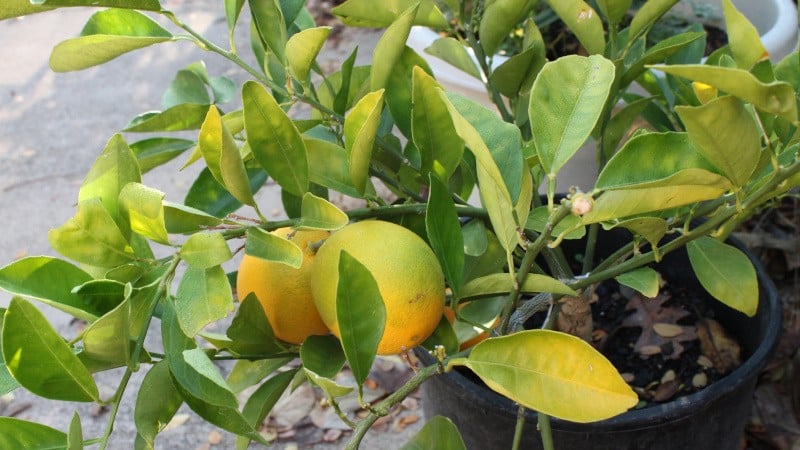
Even if you care for lemons correctly, novice gardeners run the risk of encountering a number of problems:
- The leaves have become faded. This indicates that the plant is not getting enough light or nutrients. To solve the problem, increase the amount of fertilizing and use additional lighting.
- Cobwebs on the underside of the leaf plate, drying out of greenery and shoots - symptoms of spider mite infestation. To save the plant, it is washed in the shower and sprayed with a soap solution.
- Wilting and falling leaves. In winter, such a reaction is normal for the plant. If the problem occurs during the growing season, this indicates insufficient watering or the use of cold water.
- The leaves wither and fall off, despite sufficient watering with warm water. In this case, it is important to check the roots. If there are traces of rot on them, it means that the plant is affected by a fungus. Diseased parts are removed. The cut sites are treated with a dark pink solution of potassium permanganate, and the tree is transplanted into disinfected soil.
Harvesting and application
The harvest is harvested when the fruits turn orange.The darker the fruit, the sweeter it will be. This is how the taste of lemon fruits is adjusted depending on the time of collection.
The pulp is added to salads and desserts.
Reproduction
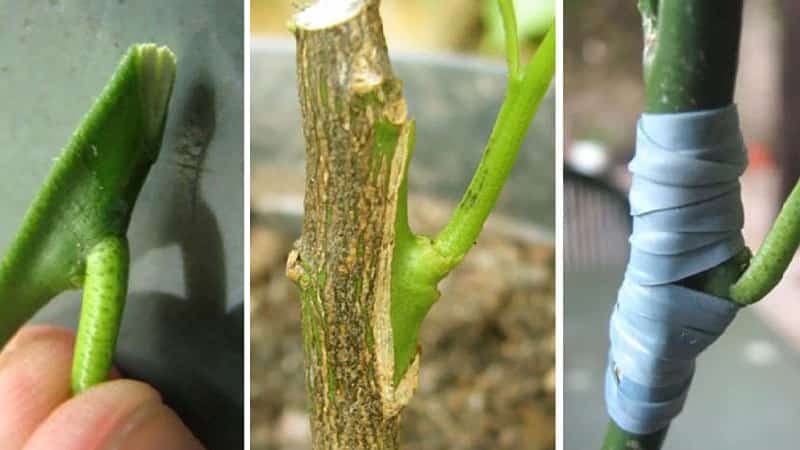
Lemon hybrids reproduce only in a vegetative way, this also applies to Meyer. Seeds collected from its fruits will produce a wild plant that does not inherit its parental characteristics.
Most often, the crop is propagated by cuttings. To do this, select a healthy one-year-old branch and prune it so that 2-3 healthy buds remain on the pruning. The cuttings are treated with a solution of potassium permanganate and Kornevin.
Advice! Reviews from citrus fruit lovers say that the hardiest hybrid lemons are obtained if they are instill on wild rootstock.
Planting material is rooted in water or soil. When shoots begin to appear from the buds, the seedling is dropped into a ceramic container with drainage holes.
Conclusion
Meyer lemon is one of the most unusual citrus fruits suitable for growing at home. Its fruits have an unusual taste and color; the tree itself is characterized by its short growth, resistance to cold weather and heat, and rapid ejection of shoots.
Despite its hardiness, Meyer citrus requires care. If watering rules are violated, the soil is insufficiently nutritious or there is a lack of light, the tree begins to hurt.